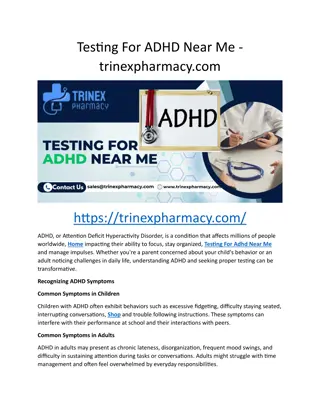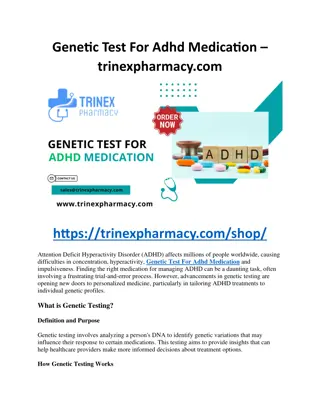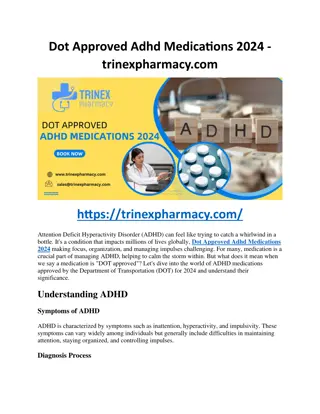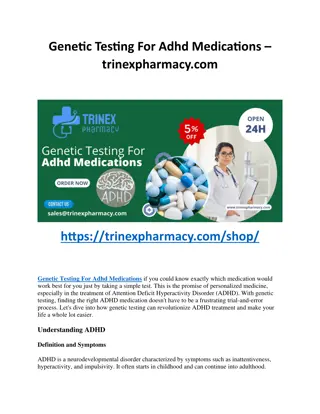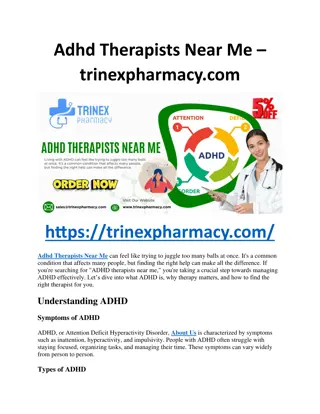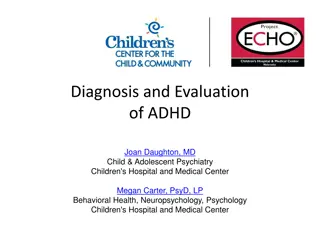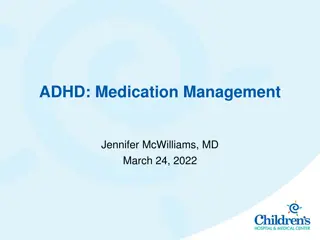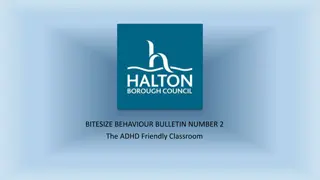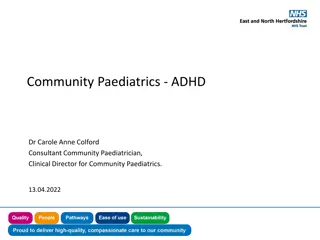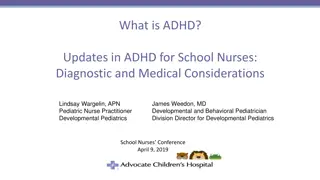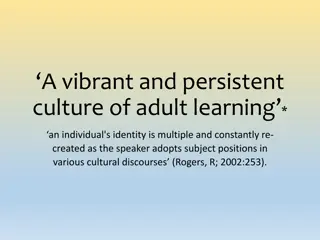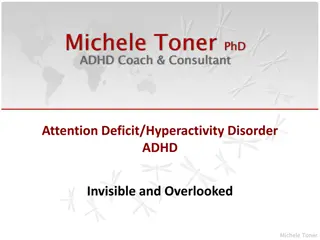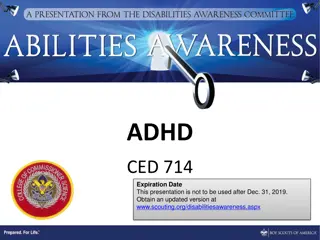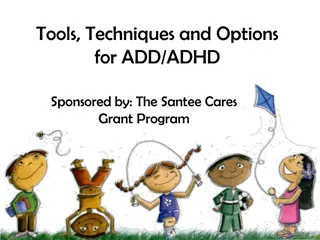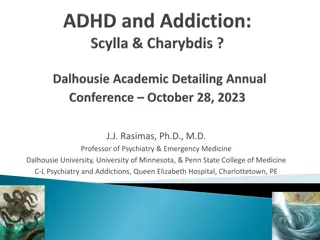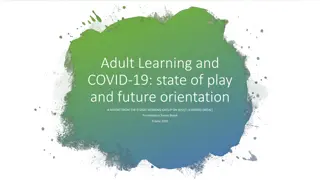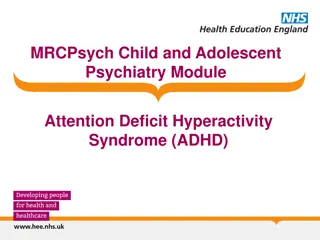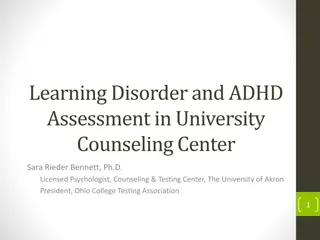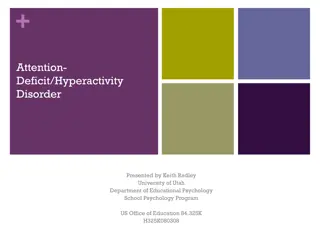Understanding Adult ADHD and its Co-Existing Challenges
Attention-deficit/hyperactivity disorder (ADHD) is a neurodevelopmental condition that can persist into adulthood, affecting about 25% of adults worldwide. The disorder is multifactorial, with genetic and environmental factors playing roles. Co-existing substance use disorders are also common among adults with ADHD, posing unique clinical challenges. Recognizing the prevalence and potential causes of adult ADHD is crucial for targeted interventions and improved outcomes.
Download Presentation

Please find below an Image/Link to download the presentation.
The content on the website is provided AS IS for your information and personal use only. It may not be sold, licensed, or shared on other websites without obtaining consent from the author. Download presentation by click this link. If you encounter any issues during the download, it is possible that the publisher has removed the file from their server.
E N D
Presentation Transcript
Adult attention deficit/hyperactivity disorder and co-existing substance use disorder: epidemiology and clinical presentation Mirjana Deli , MD
Attention-deficit/hyperactivity disorder (ADHD) is a neurodevelopmental condition characterised by persistent patterns of inattention and/or hyperactivity and impulsiveness that can lead to severe disruptive behaviour.1 Not only a childhood disorder.2-3 1. APA. Diagnostic and Statistical Manual of Mental Disorders Text Revision. 4thEdn. Washington DC: APA; 2000; 85 93. 2. Asherson. Expert Rev Neurother 2005;5:525 39. 3. Elia et al. N Engl J Med 1999;340:780 8.
ADHD has an adult prevalence rate of 25%.1,2 There is an estimated 40 60% persistence into adulthood (the full blown or in partial remission ).3 By adulthood there is a 1.5:1 M/F ratio of ADHD, and it is thought that females are likely to be underdiagnosed.1 A common reason for patient referral is that their child is diagnosed with ADHD first (20% of parents of children with ADHD will have ADHD themselves).3 1. Kooij et al. BMC Psychiatry 2010;10:67. 2. Fayyad et al. Br J Psychiatry 2007;190:402 9. 3. Faraone et al. Psych Med. 2006;36:159 165
Worldwide Prevalence of ADHD in Adults According to the 2007 WHO-WMH survey initiative, the estimated worldwide prevalence of adult ADHD is 3.4% Country Belgium Colombia France Germany Italy Lebanon Mexico The Netherlands Spain USA Total Prevalence, % (SE) 4.1 (1.5) 1.9 (0.5)a 7.3 (1.8)b 3.1 (0.8) 2.8 (0.6) 1.8 (0.7)a 1.9 (0.4)a 5.0 (1.6) 1.2 (0.6)a 5.2 (0.6) 3.4 (0.4) n 486 1,731 727 621 853 595 1,736 516 960 3,197 11,422 aUpper end of 95% CI is below the prevalence estimate for total sample bLower end of 95% CI is above the prevalence estimate for total sample 1. Fayyad et al. Br J Psychiatry 2007;190:402 9.
Potential Aetiological Factors Associated with ADHD ADHD most likely has a multifactorial aetiology, including a combination of genetic and environmental risk factors: -Approximately 80% of ADHD aetiology is linked to genetic factors -Various environmental factors may also contribute as secondary causes Potential Aetiological Factors Associated with ADHD Group Timing Aetiological Factors Genetic Mutations in the dopamine receptor and dopamine transporter genes Developmental cerebral abnormality, chromosome anomaly, virus, anaemia, hypothyroidism, iodine deficiency, exposure to drugs of abuse (e.g. nicotine) Prenatal Prematurity, low birth weight, anoxic-ischaemic encephalopathy, meningitis, encephalitis Environmental Perinatal Postnatal Viral meningitis, encephalitis, cerebral trauma, thyroid dysfunction 1. Millichap. Pediatrics 2008;121:e358 65.
Impact of ADHD Beyond Core Symptoms Healthcare System 33% in ER visits1 10x more outpatient visits2 Family Family Prone to emotional outbursts5-6 Feels demoralised over constant failure5 Low self-esteem5-6 More chaotic personal and family routines6 Higher rate of parental divorce/separation7 Prone to emotional outbursts6,11 Feels demoralized over constant failure6,11 Low self esteem6,11 More chaotic personal and family routines11 Higher rate of parental divorce/separation12,13 2-4 x sibling fights14 Patient 5x more claims for outpatient prescription2 3x more inpatient admissions2 2 4x more motor vehicle crashes3,4 Society Education and Employment Difficulties making/sustaining friendships5 Poor listening and inadequate social skills5 Quick to anger/verbally abusive when angered5 Poor financial management6 Lower occupational status8 in absenteeism9and work loss cost9-10 Poor academic grades for ability6 Misses deadlines and often misplaces things5-6 Often late for work/appointments5-6 Substance use disorders: 2x risk11 and earlier onset12 Less likely to quit smoking13 1. 2. 3. Leibson et al. 2001. Hodgkins et al. 2011. Sobanski et al. 2012. 4. 5. 6. Barkley et al. 1996. Searight et al. 2000. Weiss et al. 1999. 7. 8. 9. Brown and Pacini. 1989. Manuzza et al.1997. Secnik et al. 2005. 10. 11. 12. Birnbaum et al. 2005. Biederman et al. 1998. Milberger et al.1997. 13. Pomerleau et al.1995.
Clinical Presentation in Adults Disorganisation ( doesn t plan ahead ) Forgetfulness ( misses appointments, loses things ) Procrastination ( starts projects but can t complete ) Time management problems ( always late ) Premature shifting of activities ( starts something but then quickly distracted by something else ) Impulsive decisions (especially around spending, taking on projects, travelling, jobs or social plans) Criminal offences (speeding, illegal drugs) Unstable jobs and relationships Kooij & Francken. DIVA Foundation 2010.
Common Symptoms Inattention DSM criteria (core symptoms) Over-activity Impulsiveness Ceaseless mental activity (distracted mind) Mood lability / emotional dysregulation Associated Symptoms Low tolerance of frustration Low self-esteem Variable performance Asherson. 1st European Network Adult ADHD Conference. London, 2011.
Hyperactivity-related problems Inability to relax Restless sleep Excessively active lifestyle Constant purposeless motion of extremities Stimulus seeking or anti-social behaviours 1. Epstien J, Johnson D, Conners CK. ConnersAdult ADHS Diagnostic Interview for DSM IV. North Towanda, NY: Multi- Health Systems; 1999)
Impulsivity-related problems Disinhibited behaviour Alcohol, cannabis, cocaine, tobacco, caffeine abuse Family violence Speaking out or making decisions without considering 1. Epstien J, Johnson D, Conners CK. ConnersAdult ADHS Diagnostic Interview for DSM IV. North Towanda, 1999.
Inattention-related problems Disorganisation and inefficiency Procrastination Failure to plan ahead Forgetfulness Difficulty in multitasking Misjudging how long it takes to perform tasks Inability to complete tasks Distractibility Poor ability to follow long explanations 1. Epstien J, Johnson D, Conners CK. ConnersAdult ADHS Diagnostic Interview for DSM IV. North Towanda, NY: Multi-Health Systems; 1999. 2. Asherson. 1st European Network Adult ADHD Conference. London, 2011
Diagnosing ADHD: DSM-5 Criteria The essential feature of ADHD is a persistent pattern of inattention and/or hyperactivity-impulsivity that is more frequently displayed and more severe than is typically observed in individuals at a comparable level of development Several inattentive or hyperactive-impulsive symptoms were present prior to age 12 years Several symptoms are present in at least 2 settings (e.g. home, work, school, with friends-relatives, other activities) Symptoms interfere with social, occupational, and/or academic functioning Symptoms not due to another mental disorder APA. Diagnostic and Statistical Manual of Mental Disorders 5th Edn. Washington DC: APA; 2013;59 60.
Classifying ADHD: DSM-5 Criteria1 Presentations: -Combined -Predominantly inattentive -Predominantly hyperactive-impulsive Inattention (at least 5 symptoms for age >17) Hyperactivity-impulsivity (at least 5 symptoms for age >17) -ADHD in 'partial remission -Mild, Moderate, or Severe depending on few, intermediate, or many symptoms in excess of requirements, and minor, intermediate, or marked impairment, respectively APA. Diagnostic and Statistical Manual of Mental Disorders 5th Edn. Washington DC: APA; 2013;59 60
Diagnostic Methods 1: Clinical diagnostic interview: Evaluate each of the 18 items (DSM/ICD) both currently and retrospectively, and screen for comorbid disorders 2: Evaluation of impairments/needs: Matching symptoms to impairments is key to the diagnosis (developmental history important) 3: Screening instruments Used to screen for ADHD and monitor treatment response (Adult ADHD Self-Report Scale) 4: Psychometric tests: Not sufficiently predictive, but a useful addition to the assessment (includes: IQ-specific reading/mathematics difficulties, slow and variable responses, response inhibition, working memory, choice impulsivity) 1. Asherson. 1st European Network Adult ADHD Conference. London, 2011.
Adult ADHD Treatments Assess the relative severity of the substance use disorder (SUD), the symptoms of ADHD, and any other comorbid disorders. Stabilizing or addressing the SUD should be the first priority when treating an adult with SUD and ADHD.1. 1. Wilens TE. J Clin Psychiatry. 2004;65 Suppl 3:38-45
Multimodal Approach to Treatment Treatment should include: - Pharmacotherapy Psychoeducational Psychological - Non-pharmacological treatment Psychosocial
The clinician should begin pharmacotherapy with medications that have little likelihood of diversion or low liability, such as bupropion and atomoxetine, and, if necessary, progress to the stimulants. Careful monitoring of patients during treatment is necessary to ensure compliance with the treatment plan.1 1. Wilens TE. J Clin Psychiatry. 2004;65 Suppl 3:38-45
Pharmacotherapy Stimulants Atomoxetine Antidepressants (bupropion, desipramine) Antihypertensive medications: clonidine and guanafacine (impulsivity and hyperactivity) Antinarcolepsy medication (modafinil) Stimulants are effective in about 70% of patients with ADHD; their use in some parts of Europe is still controversial in both children and adults.
Does stimulant medications increase the risk of substance abuse in adulthood? Stimulant therapy in childhood does not increase the risk for subsequent drug and alcohol abuse disorders later in life. Growing evidence has shown that stimulants, particularly long- acting formulations, can be given safely and are not routinely abused in substance-abusing populations. Mariani and Levin, 2006, 2007; Wilens et al, 2008
Non-pharmacological Treatment 1. Education of patients and their families (psychoeducation) 2. Psychological interventions (cognitive-behavioural therapy, family therapy) 3. Psychosocial interventions Supportive coaching Marital/family counselling Career counselling Technology School/workplace accommodations Advocacy
Conclusions The age-dependent change in the presentation of ADHD symptoms People suffering from ADHD are often stereotyped as lazy, bad or agressive, or considered to have a behavioral or special needs problem rather than a mental health disorder that requires treatment Identification of comorbid conditions: mood, anxiety, psychotic, organic and SUD (in addition to personality, tic and autistic spectrum disorders) Diagnosis should include a detailed account of the developmental history; external validation Multimodal tretment



